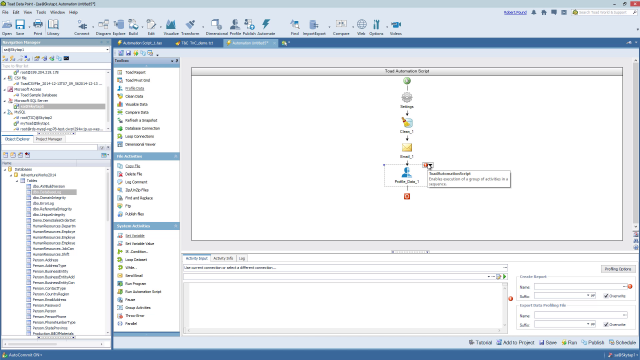Hello out there in data land. My name is Robert Pound and I am a product technologist from Quest. In this video, I would like to talk to you about automation and to Toad Data Point. Understanding and combining data are two of the major endeavors at the front end of any data analysis test. Toad Data Point addresses these issues in a number of ways. However, the focus of this video will be on automation.
Highlights of automation include the ability to run any Toad task in the automation script, the ability to visually create scripts, and-- if you have Toad Data Point Pro-- the ability to publish your automation to a single server, allowing you to collaborate around a single source as well as reduce the overhead on your individual systems.
Now let's have a closer look. So first off, how do we open automation? There are several different options. From the start page, from the ribbon bar, from tools menu you can not only open up an automation, you can open up an automation tutorial that gives you several different starting points for automation that you can walk through.
You can also, from any one of the Toad tasks, find automation in the tool bar and simply click automate. This will open up an automation task with some of the information already filled and so you can begin work with your automation straight away. In the Automation tab, first looking at the toolbox, you can see all the different database activities you have available to you in the automation itself. You also have file activity. So these include deleting or moving files, working with FTP, as well as publishing files to Toad Intelligence Central Server.
And finally have system activity. So these are some of your flow control, like if and while. You also have the ability to set variables in the system activities, as well as run other programs on the system-- send email notifications. So looking at the canvas of the automation script, first looking at settings-- so this affects things like your log level, whether you will stop on errors or continue on errors. You can embed the files in the script and change some of the email options, etc.
You also have the ability to set up both a test and production environment. So if you want to test on one connection, and then move it to a different one, you can. And to add activities to the canvas, you can either drag or double click an item and it will show up. This red arrow indicates that there is a problem with the script. It's not complete. And that's obviously because we just added it. And it will highlight where it needs to be completed. In this case there's no information yet.
But that brings us to the bottom activity's window itself. So for each one of the activities, as I scroll through, you're going to have an input. This is whatever pertinent information for the given activity. In the case of an email, email address, transform and cleanse a file, and export file, etc.
So this is all your input information. You also have an activity information. So this allows you to name the different activities. It may not seem important with three different activities. But if you have several dozen of them and there are several different transforms in the cleanse, clean one, two, three, four, and five may not help you. But if you have named it appropriate to the task, then it will help you easily understand your script. And you can also give a description as well.
And then the log just gets you to the log information for this particular automation script. Let me go ahead and delete this real quick. And one more thing in the activity information. So you can choose to enable and disable any of the activities in the script. This may be helpful when you're trying to troubleshoot a larger script. You can disable certain portion of it and continue running the script, and then enable it when you want to run the full script.
So looking at the toolbar-- both the top and bottom-- you can add this particular automation script to your projects to save it to the file system. You can run either here or here.
And you also have the ability to publish to Toad Intelligence Central Server and schedule it. And that's the overview for automation and Toad Data Point. Hopefully this helped you understand a little bit about automation and how it can help you in your day to day tasks.
To get more information on this or other topics, you can view the Toad Help file, which has a wide range of information, including tutorials specifically for automation. You can also check out the community driven innovation going on at www.toadworld.com.
I encourage you to log in to the tool so you can get content specific to Toad Data Point. For more information on this product, you can visit www.quest.com/products/Toad-Data-Point.
Thank you and have a great day.
 05:41
05:41
